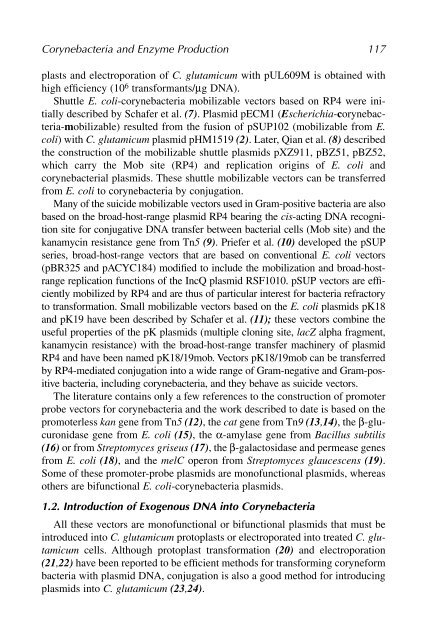Microbial Enzymes and Biotransformations Microbial Enzymes and ...
Microbial Enzymes and Biotransformations Microbial Enzymes and ...
Microbial Enzymes and Biotransformations Microbial Enzymes and ...
You also want an ePaper? Increase the reach of your titles
YUMPU automatically turns print PDFs into web optimized ePapers that Google loves.
Corynebacteria <strong>and</strong> Enzyme Production 117<br />
plasts <strong>and</strong> electroporation of C. glutamicum with pUL609M is obtained with<br />
high efficiency (10 6 transformants/µg DNA).<br />
Shuttle E. coli-corynebacteria mobilizable vectors based on RP4 were initially<br />
described by Schafer et al. (7). Plasmid pECM1 (Escherichia-corynebacteria-mobilizable)<br />
resulted from the fusion of pSUP102 (mobilizable from E.<br />
coli) with C. glutamicum plasmid pHM1519 (2). Later, Qian et al. (8) described<br />
the construction of the mobilizable shuttle plasmids pXZ911, pBZ51, pBZ52,<br />
which carry the Mob site (RP4) <strong>and</strong> replication origins of E. coli <strong>and</strong><br />
corynebacterial plasmids. These shuttle mobilizable vectors can be transferred<br />
from E. coli to corynebacteria by conjugation.<br />
Many of the suicide mobilizable vectors used in Gram-positive bacteria are also<br />
based on the broad-host-range plasmid RP4 bearing the cis-acting DNA recognition<br />
site for conjugative DNA transfer between bacterial cells (Mob site) <strong>and</strong> the<br />
kanamycin resistance gene from Tn5 (9). Priefer et al. (10) developed the pSUP<br />
series, broad-host-range vectors that are based on conventional E. coli vectors<br />
(pBR325 <strong>and</strong> pACYC184) modified to include the mobilization <strong>and</strong> broad-hostrange<br />
replication functions of the IncQ plasmid RSF1010. pSUP vectors are efficiently<br />
mobilized by RP4 <strong>and</strong> are thus of particular interest for bacteria refractory<br />
to transformation. Small mobilizable vectors based on the E. coli plasmids pK18<br />
<strong>and</strong> pK19 have been described by Schafer et al. (11); these vectors combine the<br />
useful properties of the pK plasmids (multiple cloning site, lacZ alpha fragment,<br />
kanamycin resistance) with the broad-host-range transfer machinery of plasmid<br />
RP4 <strong>and</strong> have been named pK18/19mob. Vectors pK18/19mob can be transferred<br />
by RP4-mediated conjugation into a wide range of Gram-negative <strong>and</strong> Gram-positive<br />
bacteria, including corynebacteria, <strong>and</strong> they behave as suicide vectors.<br />
The literature contains only a few references to the construction of promoter<br />
probe vectors for corynebacteria <strong>and</strong> the work described to date is based on the<br />
promoterless kan gene from Tn5 (12), the cat gene from Tn9 (13,14), the β-glucuronidase<br />
gene from E. coli (15), the α-amylase gene from Bacillus subtilis<br />
(16) or from Streptomyces griseus (17), the β-galactosidase <strong>and</strong> permease genes<br />
from E. coli (18), <strong>and</strong> the melC operon from Streptomyces glaucescens (19).<br />
Some of these promoter-probe plasmids are monofunctional plasmids, whereas<br />
others are bifunctional E. coli-corynebacteria plasmids.<br />
1.2. Introduction of Exogenous DNA into Corynebacteria<br />
All these vectors are monofunctional or bifunctional plasmids that must be<br />
introduced into C. glutamicum protoplasts or electroporated into treated C. glutamicum<br />
cells. Although protoplast transformation (20) <strong>and</strong> electroporation<br />
(21,22) have been reported to be efficient methods for transforming coryneform<br />
bacteria with plasmid DNA, conjugation is also a good method for introducing<br />
plasmids into C. glutamicum (23,24).

















